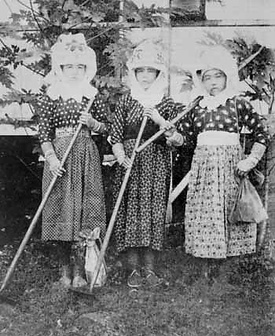1.First of all
From the end of the 19th century to the beginning of the 20th century, many Japanese immigrants came to Hawaii, just as they did to the West Coast of the United States. By 1900, Japanese people had already accounted for nearly 40 percent of Hawaii's total population.

オアフのカワイロア砂糖プランテーションで働く福島県出身の一世女性。1906年。Collection of Barbara Kawakami, Japanese American National Museum (NRC.1997.41.1)
Until the 1910s, most of the workers on sugar plantations were Japanese immigrants. Working conditions were particularly bad from the late 19th century to the early 20th century, and there were two particularly large strikes on sugar plantations, in 1909 and 1920, mainly by Japanese immigrants, and strikes by other ethnic groups as well. However, the power of the Big Five, the five major companies that controlled the sugar industry, was so great that the workers almost never won. Starting a labor dispute caused considerable damage to the workers. After the 1920 strike, some Japanese workers who had participated in the strike on Oahu did not return to their original plantations, but instead went to work in the city of Honolulu, rented land to grow sugar cane, or took up other jobs.
In this report, I will first take a quick look at tanka, haiku, and senryu poems from the 1930s that describe the working conditions and scenes of sugarcane fields, and then introduce poems that give insight into how Issei poets viewed the social climate and working conditions of the time.
I will then give an overview of the labor situation in Hawaii from the 1930s to the 1940s, and introduce some songs and poems that give a glimpse into how the Issei viewed the labor activists who rose up for equality after World War II and the Nisei's activities within them. I will explore the Issei's feelings of joy, pride, and mixed emotions regarding the Nisei's actions.
2. Sugarcane plantation labor
The sedge has grown so long that the town is no longer visible.
(From Yokoyama Shosei's 1939 work "Aikane")
Without a word, the sound of the bell could be heard.
(From Yokoyama Shosei's 1930 work "Aikane")
There are many poems that describe the various tasks of working in the millet fields. When sugarcane grows, it becomes very tall. When the ears appear on the millet, the sugarcane becomes sweeter. The ears of sugarcane also represent the seasons. Then they are harvested. Kachiken means cut cane.
The candy flows, Takahi is watched over, Hinaga is
(Gyokuto, Hiro Shoo Association, mutually selected haiku, March 1935)
Cutting the bushes, the long gutter and the clear May day
(From Yokoyama Shosei's 1930 work "Aikane")
Spring arrives, the sound of sugarcane flowing through the gutters
(Shido Hiro Shoo Association, mutually selected haiku, January 1933)
The swell of the flume can be seen in the mountain fields where millet has been cut, and it is a summer morning.
(Masuda Tamaho, "Silver Rain" published in 1925)
The harvested sugarcane was poured into gutters (called "toi" or "kakehi" but sometimes called "flumes" or "flumes" using the English word "flume") that ran through the millet fields, and collected at collection points for transport to sugar factories. As the poem suggests, the gutters wound and twisted through the millet fields like long snakes. Some of the gutters reached very high altitudes.
The work of carrying and stacking millet was called hapaikou and required a lot of strength. This work is also depicted in the songs.
The sugar cane is piled up, the voice is strong, the sun is strong
(Kouryu Hiro Shoo Association, mutually selected haiku, May 1933)
There are many poems that describe sugar ships that set sail for the mainland loaded with sugar.
A sugar ship, a whistle leaving the island at night
(From Shosei Yokoyama's "Aikane")
According to the Hawaiian Saijiki, sugar ships are a seasonal word for spring. After the Kachiken season, sugarcane is transported to sugar factories in Hawaii, where it is boiled down to extract the sugar, making raw sugar. This raw sugar is then loaded onto sugar ships and sent to sugar refineries on the American mainland. This poem describes the harvest season, when many sugar ships head for the mainland. Meanwhile, the harvested fields are burned down.
In the midst of the burning of sugarcane and the night sky, the mules flow
(Yuutori, Hiro Shoo Association, February 1934 regular meeting haiku collection)
The smoke of the wildfires creeping over the sugarcane, the heat of spring
(Hiro Shoo Association, March 1934 regular meeting collection)
These poems describe the scene of burnt farming. The scene of burning dried millet fields was a good subject for haiku. Lava means volcanic lava. This poem describes the scene of burning millet on the Big Island of Hawaii, and says that at night, the fire of the millet burning looks like hot lava flowing from the crater.
The sweet smell rising from the chimneys of sugar factories in autumn also tickles the hearts of poets.
The sweet praises of the sugar mills, the heat of autumn
(Hiro Toyomura, Selected Poems of the Hiro Shoo Society, November 1933)
3. The Japanese American Community and Labor Disputes of the 1930s
When you listen to these songs, you may have an image of working on a Hawaiian sugar plantation being peaceful and prosperous. Of course, it is true that the lives of the first generation immigrants became more prosperous as their families and picture brides were brought over. The 1930s was actually a time when the Hawaiian Japanese community celebrated "Hawaiian Japanese culture." However, the work was tough, and life in the sugar plantation camps was not easy. Of course, the Great Depression affected Hawaii in the 1930s. During this time, some workers tried to stand up together to improve their conditions. However, in the 1930s, the second generation of Japanese were able to work together with workers of other ethnic backgrounds without communication barriers, but the number of second generation Japanese who had reached adulthood at that time was still small.
Also, since the Nikkei who enjoyed haiku and tanka were first-generation Japanese speakers, it is not yet possible to find many songs or poems that express the voices of those who wanted to stand up as workers. However, there are poems and poems that look at the strike objectively or that were written in response to the strike.
In the sugar industry in Hawaii, large companies that owned plantations were in charge of all stages of sugar production, from plowing the land, planting the sugar cane, tending it, harvesting it, and shipping it to sugar companies on the U.S. mainland. They also handled everything from the sugar trains that were used for transportation, the installation and supervision of the aforementioned cane ditches, irrigation, the maintenance and operation of the sugar ships, food for the workers, and the provision of housing.
In Hawaii, five major companies dominated the industry, hence the name "Big Five." The songs and poems we have looked at so far have been about sugarcane plantations, but in fact the sugar jobs that Japanese people worked in were diverse, and it is no exaggeration to say that they were all under the umbrella of the Big Five. Not only the farm workers, but also the dock workers were first and second generation immigrants from many ethnic backgrounds, and their working conditions were harsh.
In addition, the main commercial crops in Hawaii were sugar, pineapples, and coffee, and general food (vegetables, fruits, and other daily necessities) were shipped in from the U.S. mainland. Therefore, if the dock workers went on strike, it would have a major impact on daily life in Hawaii.
In fact, Hawaiian society was undergoing change in the 1930s. White labor activists, who had been influenced by the labor movement that had been gaining momentum on the west coast of the mainland, came to Hawaii one after another, observed the situation of Hawaiian workers closely, and began to organize workers across ethnic lines. In fact, small-scale strikes broke out all over Hawaii during the 1930s, amid the economic depression. In 1936, there was a dock strike. Until then, even if there were strikes, they were only by workers of a single ethnic background (i.e. only Japanese or only Filipinos), and they were limited to a certain area. In addition, the power of the Big Five companies extended to the authorities, so they were not very successful. But things started to change little by little in the 1930s.
We will introduce some poems and haiku written by Issei poets living on the island of Hawaii that describe the strike.
<Strike to Go Forward>
The unusual smell of the sea on a cloudy autumn day
(Yuutori, Hiro Shoo Association, mutually selected haiku, November 1936)
In the autumn rains, the police officers are escorting the cargo.
(Fuyou, Hiro Shoo Association, mutually selected haiku, November 1936)
Smoke from the strike ships, autumn rain
(Red Storm, Hiro Shoo Association, mutually selected haiku, November 1936)
Autumn rains come as strikers face off against police
(Fuyou, Hiro Shoo Association, mutually selected haiku, November 1936)
The above is a description of the strikers seen on the wharves and in the streets. Hilo on the Big Island of Hawaii is a rainy place, so the image of the rain-soaked strikers glaring at the police must have touched the poet's heart.
<About the ship strike>
Canned Traveler and Autumn on the Island
(Issei (Shosei Yokoyama), Hiro Shoo Association, mutually selected haiku, November 1936)
In Hawaii, Oahu, where Honolulu is located, is the political and economic center, so people on the outlying islands, such as Hawaii Island, Kauai, and Maui, often have to travel to Honolulu by boat. However, if the shipping companies go on strike, that is the only way to get to Honolulu, so people end up being stuck on the outlying islands.
<Strike ships>
The potato sprouts are spreading on the boat. It's early spring.
(Shido Hiro Shoo Association, mutually selected haiku, December 1936)
An extra newspaper announcing the end of the strike spreads across the town
(Haarai, Hiro Shoo Association, mutually selected haiku, January 1937)
The song describes how, while a ship loaded with potatoes for food was stuck in port due to the strike, the potatoes sprouted and spread. That is how long the strike had been going on. The lines about the end of the strike convey the joy of being freed from a restrictive lifestyle, rather than the outcome of the strike itself.
*This is the manuscript of a presentation given in the Japanese session " Issei Poetry, Issei Voices " at the Japanese American National Museum's nationwide conference " Speaking Up! Democracy, Justice, Dignity, " held from July 4 to 7, 2013.
Listen to this session's presentation (audio only) >>
© 2013 Mariko Takagi-Kitayama










